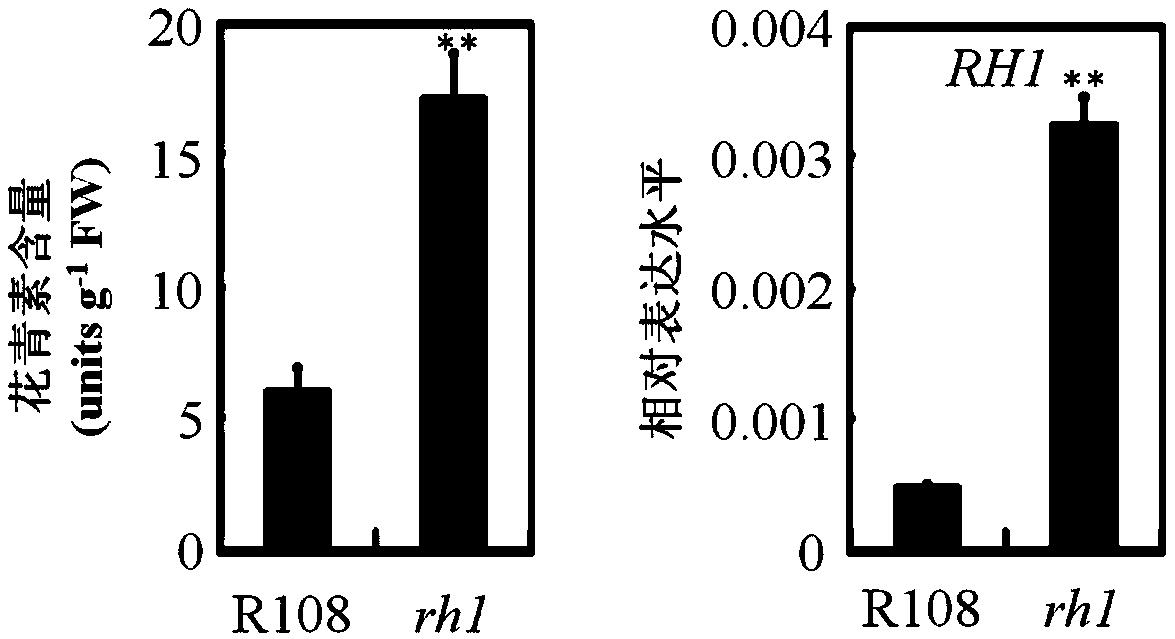Anthocyanin synthesis related proteins and application in regulating anthocyanin content of plants
A technology for anthocyanin content and related proteins, which is applied in the application field of regulating and controlling plant anthocyanin content
- Summary
- Abstract
- Description
- Claims
- Application Information
AI Technical Summary
Problems solved by technology
Method used
Image
Examples
Embodiment 1
[0114] Embodiment 1, the discovery of RH1 and its coding gene RH1 gene
[0115] 1. Mutant acquisition and phenotype analysis
[0116] In The Nobel Foundation, by screening the Tnt1 insertion mutant library of Medicago truncatula, a mutant with abnormal anthocyanin synthesis was isolated and obtained. The mutant was numbered NF7599 in the Tnt1 database, and it mainly manifested in the specific accumulation of anthocyanins on leaves. The phenotype of red heart was presented, and the mutant was named red heart1(rh1). The mutant was crossed with wild-type Medicago truncatula R108 to obtain F 1 Expressed as an intermediate type with a lighter red heart, F 2 Three phenotypes were isolated from the population: wild type, intermediate type with lightened red heart and red heart phenotype, and the segregation ratio was 1:2:1 (p=0.754>0.05). It shows that for wild-type R108, the red heart trait of rh1 mutant is controlled by a semi-dominant single gene.
[0117] The leaf phenotype o...
Embodiment 2
[0138] Example 2, Functional Verification of RH1 Gene
[0139] 1. Construction of CRISPR / Cas9 genome editing vector
[0140] Using pMtU6-Cas (Meng et al., 2017, Targeted mutagenesis by CRISPR / Cas9system in the model legume Medicago truncatula, Plant Cell Rep (2017) 36:371–374) as a template, using the primer pair MtU6-F1 and MtU6-R1 Perform PCR amplification to obtain the MtU6 promoter; use primer pair 1 (composed of 40-sgRNA-F1 primers and R2 primers) and primer pair 2 (composed of 40-sgRNA-F2 primers and R2 primers) for PCR amplification, respectively, Obtain two DNA fragments encoding the sgRNA targeting the target fragment and the scaffold respectively, that is, the sgRNA1-scaffold fragment and the sgRNA2-scaffold fragment. Using the mixture of MtU6 promoter and sgRNA1-scaffold fragment as a template, PCR amplification was performed using a primer pair (composed of MtU6-F1 and R2) to obtain pMtU6::sgRNA1-scaffold fragment; using MtU6 promoter and sgRNA2-scaffold fragment ...
Embodiment 3
[0168] Embodiment 3, the anthocyanin content of Medicago truncatula of transfection RH1 gene increases
[0169] This example further illustrates that the RH1 gene can increase the anthocyanin content of Medicago truncatula by introducing the RH1 gene into wild-type Medicago truncatula R108. The specific method is as follows:
[0170] 1. Construction of recombinant vector
[0171] Using the genomic DNA of the mutant rh1 as a template, PCR amplification was carried out with primers 40-PRO-EcoRI-F and 40-3'UTR-PstI-R to obtain the DNA fragment shown in sequence 3 of the sequence table; the pCAMBIA2300 The DNA fragment between the EcoRI and PstI recognition sequences was replaced with the DNA fragment shown in Sequence 3, and the resulting recombinant vector was named pCAMBIA2300-RH1pro::RH1. pCAMBIA2300-RH1pro::RH1 can express the protein shown in sequence 1 in the sequence listing. The primer sequences used are:
[0172] 40-PRO-EcoRI-F:5'-ccatgattacgaattcACTCGTATGTGGGGATTTTGA-3...
PUM
 Login to View More
Login to View More Abstract
Description
Claims
Application Information
 Login to View More
Login to View More - R&D
- Intellectual Property
- Life Sciences
- Materials
- Tech Scout
- Unparalleled Data Quality
- Higher Quality Content
- 60% Fewer Hallucinations
Browse by: Latest US Patents, China's latest patents, Technical Efficacy Thesaurus, Application Domain, Technology Topic, Popular Technical Reports.
© 2025 PatSnap. All rights reserved.Legal|Privacy policy|Modern Slavery Act Transparency Statement|Sitemap|About US| Contact US: help@patsnap.com



